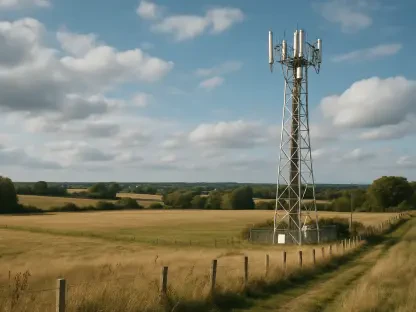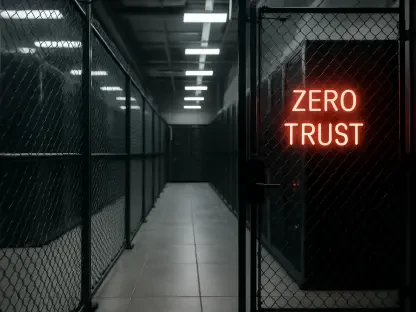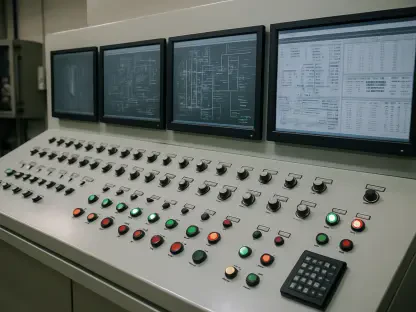Imagine a sprawling industrial facility where machines hum tirelessly, controlled by intricate systems, yet a single cyber breach could halt operations in seconds, costing millions in losses and downtime. This scenario underscores the urgent need for seamless integration between Information Technology (IT) and Operational Technology (OT), two domains that have long operated in isolation. IT governs the digital infrastructure of corporate environments, while OT manages the hardware and software driving industrial processes in factories, utilities, and ports. The convergence of these spheres is no longer optional but a critical necessity to enhance security and efficiency. This review delves into Cisco’s pioneering efforts to bridge this gap, examining their innovative solutions, performance in real-world settings, and their potential to redefine industrial cybersecurity.
Understanding the IT/OT Divide and Cisco’s Approach
The distinction between IT and OT has historically created operational silos, with IT focusing on data networks and OT on physical process control. This separation often results in inefficiencies, as disparate systems struggle to communicate, and security gaps emerge from inconsistent protocols. Industrial environments, reliant on OT, become vulnerable to cyber threats when not aligned with robust IT security practices, amplifying risks in an era of increasing connectivity.
Cisco has positioned itself as a leader in addressing this divide by advocating for a unified architecture that ensures seamless interaction between IT and OT systems. Their strategy emphasizes not just connectivity but also comprehensive security, recognizing that a breach in one domain can ripple across the entire organization. By integrating advanced networking and cybersecurity tools, Cisco aims to eliminate blind spots and foster collaboration across traditionally segregated teams.
This approach aligns with the broader technological shift toward the industrial Internet of Things (IoT) and cybersecurity convergence. As industries digitize operations, Cisco’s initiatives offer a blueprint for harmonizing environments, ensuring that both digital and physical assets are protected under a single, cohesive framework.
Core Features of Cisco’s IT/OT Solutions
Cyber Vision OT Management Suite
Cisco’s Cyber Vision stands as a cornerstone of their OT security offerings, providing real-time monitoring of industrial devices and mapping their interactions with IT networks. This tool delivers critical visibility into often opaque OT environments, allowing organizations to track connected assets and detect irregularities that could signal threats such as malware or unauthorized access. Its ability to provide a clear picture of network activity is essential for maintaining operational integrity.
A standout feature of Cyber Vision is its AI-powered asset clustering, which automates the grouping of devices into logical zones for network segmentation. This capability significantly reduces the time needed to isolate threats, ensuring rapid containment without manual intervention. Such automation is vital in high-stakes industrial settings where delays can lead to catastrophic consequences.
Moreover, Cyber Vision integrates with Cisco’s extended detection and response platform, merging IT and OT asset inventories for streamlined threat investigations. This synergy enables a holistic view of an organization’s infrastructure, ensuring that anomalies in one domain are contextualized across the entire network, thus enhancing overall security posture.
Secure Equipment Access and Remote Security
In an age where remote access to industrial systems is increasingly common, Cisco has paired Cyber Vision with Secure Equipment Access (SEA) to bolster protection against suspicious logins. This integration monitors access patterns, flagging activities that deviate from the norm, such as logins at unusual hours or from unexpected locations. It addresses a growing concern as connectivity expands the attack surface in industrial environments.
The use of AI assistance within SEA further enhances efficiency by identifying unusual behaviors without the need for tedious manual log reviews. Administrators can focus on critical tasks while the system prioritizes alerts, reducing human error and response times. This feature proves invaluable for industries where remote operations are routine, ensuring security without sacrificing accessibility.
The emphasis on secure remote access reflects a broader recognition of evolving workforce dynamics, where personnel often manage systems from diverse locations. Cisco’s solutions provide a robust mechanism to safeguard these interactions, maintaining trust in an interconnected operational landscape.
Industry Trends Shaping IT/OT Convergence
The drive toward IT/OT integration extends beyond Cisco, representing a fundamental shift across the technology sector. Competitors such as HPE/Juniper, Extreme Networks, Palo Alto, and Fortinet are also developing solutions to merge these domains, indicating a consensus that isolated systems are unsustainable amid modern cyber threats. This collective momentum highlights the urgency of unified approaches in safeguarding industrial ecosystems.
Analyst reports, such as those from IDC, advocate for unified threat detection that leverages telemetry from both IT and OT environments. This method enables the identification of sophisticated attacks that might evade detection in siloed setups, emphasizing the need for correlated data to uncover hidden patterns. Such insights are shaping how organizations prioritize their cybersecurity investments.
Additionally, the operational and cost benefits of a single architecture are gaining traction. By consolidating tools and processes, companies can minimize complexity, reduce expenses tied to disparate systems, and accelerate incident response. This trend toward efficiency is a key driver behind the adoption of integrated solutions, positioning convergence as a strategic imperative for forward-thinking enterprises.
Real-World Impact Across Industries
Cisco’s IT/OT solutions are making tangible differences in sectors like manufacturing, utilities, and logistics, where operational continuity is paramount. In manufacturing plants, for instance, their technologies enable seamless data flow between shop floor equipment and corporate systems, optimizing production while securing critical assets. These implementations demonstrate the practical value of integration in high-pressure environments.
A specific example lies in the deployment of Cisco’s IE3500 rugged switches, built to withstand harsh industrial conditions. These switches support low-latency IoT applications, integrating wireless backhaul and Wi-Fi to facilitate mobile operations in settings like warehouses and ports. Their durability and performance ensure reliable connectivity where traditional hardware might fail.
Unique use cases further illustrate versatility, such as enabling real-time analytics at the edge for utility substations. By bridging IT and OT, Cisco’s solutions allow for immediate decision-making in remote locations, enhancing both efficiency and security. These applications underscore the transformative potential of integration across diverse operational contexts.
Challenges Hindering Seamless Integration
Despite the promise of IT/OT convergence, significant obstacles persist, notably the aging infrastructure prevalent in many industrial settings. According to IDC, a substantial portion of OT assets are over a decade old, lacking modern security features and posing inherent risks. Upgrading these systems without disrupting operations remains a daunting challenge for many organizations.
Another critical issue is the vulnerability of unsegmented OT networks, which allow lateral movement during cyberattacks, amplifying damage. Unlike IT environments where segmentation is standard, OT systems often prioritize uptime over security, leaving them exposed. This structural weakness necessitates innovative approaches to protect legacy setups without halting critical processes.
Cisco addresses these hurdles through adaptive security policies and real-time segmentation, designed to minimize interference with ongoing operations. However, broader challenges like regulatory complexities and the need for collaboration between IT and OT teams continue to complicate progress. Overcoming these barriers requires not just technology but also cultural shifts within organizations to align priorities and expertise.
Future Directions for Cisco’s Strategy
Looking ahead, Cisco’s roadmap for IT/OT integration includes the development of a unified dashboard for Catalyst and Meraki networks, set to enhance visibility for both IT and OT teams. This centralized interface promises to break down remaining silos, offering a comprehensive view of assets, traffic, and security status. Such advancements signal a commitment to simplifying management in complex environments.
Potential breakthroughs in AI-driven security and edge computing also loom on the horizon, poised to further revolutionize industrial applications. By embedding intelligence closer to operational endpoints, Cisco could enable faster, more autonomous responses to threats, reducing dependency on centralized systems. This evolution holds promise for industries requiring instantaneous decision-making.
Over the long term, the impact of IT/OT convergence on industrial efficiency and cybersecurity is expected to deepen, fostering unprecedented collaboration across teams. As these domains merge, the ability to anticipate and mitigate risks will become a competitive differentiator, with Cisco well-positioned to lead through continuous innovation and strategic foresight.
Final Reflections on Cisco’s Contributions
Reflecting on this evaluation, Cisco’s strides in IT/OT integration prove to be a robust response to the pressing challenges of industrial cybersecurity and operational efficiency. Their suite of tools, including Cyber Vision and Secure Equipment Access, tackles legacy vulnerabilities head-on, while real-world deployments showcase adaptability across diverse sectors. The emphasis on visibility and segmentation emerges as a cornerstone of their success in fortifying interconnected environments.
Looking forward, organizations adopting these solutions should prioritize aligning IT and OT teams through shared training and protocols, ensuring technology is matched by cultural integration. Exploring partnerships with Cisco to tailor solutions for specific industry needs could further amplify outcomes. As the landscape evolves, staying attuned to emerging AI and edge computing capabilities will be crucial for maintaining a proactive stance against future threats.









